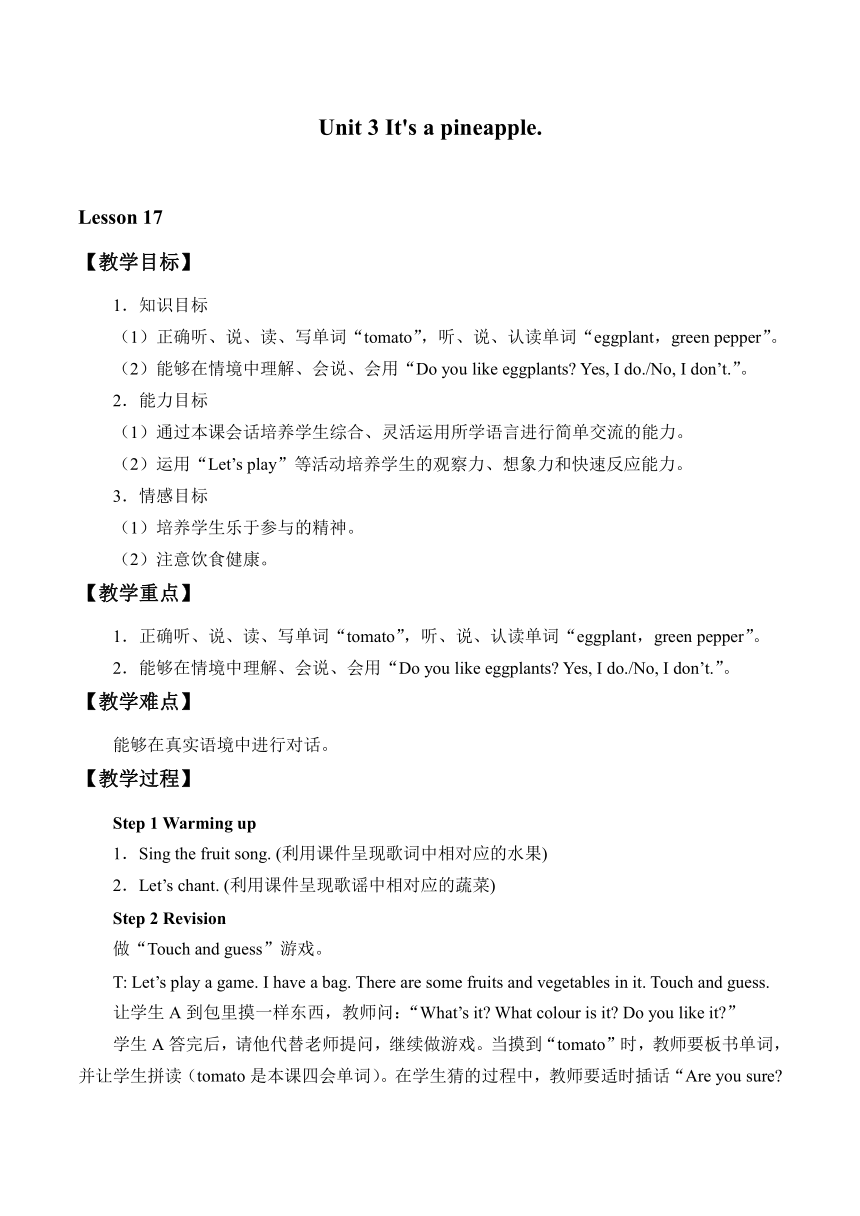Unit 3 It's a pineapple.教案
文档属性
| 名称 | Unit 3 It's a pineapple.教案 |  | |
| 格式 | docx | ||
| 文件大小 | 13.4KB | ||
| 资源类型 | 教案 | ||
| 版本资源 | 人教精通版(三年级起点) | ||
| 科目 | 英语 | ||
| 更新时间 | 2024-11-02 09:46:20 | ||
图片预览

文档简介
Unit 3 It's a pineapple.
Lesson 17
【教学目标】
1.知识目标
(1)正确听、说、读、写单词“tomato”,听、说、认读单词“eggplant,green pepper”。
(2)能够在情境中理解、会说、会用“Do you like eggplants Yes, I do./No, I don’t.”。
2.能力目标
(1)通过本课会话培养学生综合、灵活运用所学语言进行简单交流的能力。
(2)运用“Let’s play”等活动培养学生的观察力、想象力和快速反应能力。
3.情感目标
(1)培养学生乐于参与的精神。
(2)注意饮食健康。
【教学重点】
1.正确听、说、读、写单词“tomato”,听、说、认读单词“eggplant,green pepper”。
2.能够在情境中理解、会说、会用“Do you like eggplants Yes, I do./No, I don’t.”。
【教学难点】
能够在真实语境中进行对话。
【教学过程】
Step 1 Warming up
1.Sing the fruit song. (利用课件呈现歌词中相对应的水果)
2.Let’s chant. (利用课件呈现歌谣中相对应的蔬菜)
Step 2 Revision
做“Touch and guess”游戏。
T: Let’s play a game. I have a bag. There are some fruits and vegetables in it. Touch and guess.
让学生A到包里摸一样东西,教师问:“What’s it What colour is it Do you like it ”
学生A答完后,请他代替老师提问,继续做游戏。当摸到“tomato”时,教师要板书单词,并让学生拼读(tomato是本课四会单词)。在学生猜的过程中,教师要适时插话“Are you sure Is it...or... ”,使学生逐渐接触本课的新知识点。
Step 3 Presentation
1.学习新单词
继续做复习环节的游戏。这时,教师悄悄将本课要学的“eggplant, green pepper”这两样蔬菜放到包里,再找学生摸一摸,猜一猜。这次有的学生可能回答:“Sorry, I don’t know.”有的可能用汉语说出“茄子”或“青椒”,教师趁机拿出实物引导学生说:“This is an eggplant. This is a green pepper.”教师再举起实物问:“What’s this ” 学生就能回答:“It’s a (an)...”教师边领读单词,边将“eggplant, green pepper”的贴画贴到黑板上。
2.学习新句型
T: Let’s play a game again.
在黑板上贴一张西红柿的图片,但只露出一角,让学生认为是苹果。然后问学生:“Guess what this is ”学生也许回回答“It’s an apple.”,师问:“Are you sure ”,学生回答:“Yes!”。
3.学习对话:
(1)T: Let’s watch video.
利用课件看一段短片,熟悉一下本课内容,并培养了学生的模仿能力。
(2)T: Look at the picture. Listen and read. (课件呈现本课教学图片,并播放录音)
(3)T: Act out the dialogue.
学生利用教学准备好的实物,先分组练习,再到前面来表演。
Step 4 Practice
1.Riddles
T: Here are some riddles about fruits and vegetables. Guess what they are 课件呈现谜语内容,教师读完后,如学生点中正确的答案,奖励贴画。
2.Listen and do.
教师把教学准备的图片、实物发给学生,然后让学生听指令完成任务。
T: Pass me the... Show me the... Peel the... Eat the...
3.Listen and tick or cross.利用课件做蔬菜、水果的听力练习,巩固所学知识。
Step 5 Homework
1.Make up a new dialogue.
2.课后同学之间继续做猜东西游戏。
【板书设计】
Lesson 17
Do you like eggplants
Yes, I do. /No, I don’t.
tomato eggplant green pepper
Lesson 17
【教学目标】
1.知识目标
(1)正确听、说、读、写单词“tomato”,听、说、认读单词“eggplant,green pepper”。
(2)能够在情境中理解、会说、会用“Do you like eggplants Yes, I do./No, I don’t.”。
2.能力目标
(1)通过本课会话培养学生综合、灵活运用所学语言进行简单交流的能力。
(2)运用“Let’s play”等活动培养学生的观察力、想象力和快速反应能力。
3.情感目标
(1)培养学生乐于参与的精神。
(2)注意饮食健康。
【教学重点】
1.正确听、说、读、写单词“tomato”,听、说、认读单词“eggplant,green pepper”。
2.能够在情境中理解、会说、会用“Do you like eggplants Yes, I do./No, I don’t.”。
【教学难点】
能够在真实语境中进行对话。
【教学过程】
Step 1 Warming up
1.Sing the fruit song. (利用课件呈现歌词中相对应的水果)
2.Let’s chant. (利用课件呈现歌谣中相对应的蔬菜)
Step 2 Revision
做“Touch and guess”游戏。
T: Let’s play a game. I have a bag. There are some fruits and vegetables in it. Touch and guess.
让学生A到包里摸一样东西,教师问:“What’s it What colour is it Do you like it ”
学生A答完后,请他代替老师提问,继续做游戏。当摸到“tomato”时,教师要板书单词,并让学生拼读(tomato是本课四会单词)。在学生猜的过程中,教师要适时插话“Are you sure Is it...or... ”,使学生逐渐接触本课的新知识点。
Step 3 Presentation
1.学习新单词
继续做复习环节的游戏。这时,教师悄悄将本课要学的“eggplant, green pepper”这两样蔬菜放到包里,再找学生摸一摸,猜一猜。这次有的学生可能回答:“Sorry, I don’t know.”有的可能用汉语说出“茄子”或“青椒”,教师趁机拿出实物引导学生说:“This is an eggplant. This is a green pepper.”教师再举起实物问:“What’s this ” 学生就能回答:“It’s a (an)...”教师边领读单词,边将“eggplant, green pepper”的贴画贴到黑板上。
2.学习新句型
T: Let’s play a game again.
在黑板上贴一张西红柿的图片,但只露出一角,让学生认为是苹果。然后问学生:“Guess what this is ”学生也许回回答“It’s an apple.”,师问:“Are you sure ”,学生回答:“Yes!”。
3.学习对话:
(1)T: Let’s watch video.
利用课件看一段短片,熟悉一下本课内容,并培养了学生的模仿能力。
(2)T: Look at the picture. Listen and read. (课件呈现本课教学图片,并播放录音)
(3)T: Act out the dialogue.
学生利用教学准备好的实物,先分组练习,再到前面来表演。
Step 4 Practice
1.Riddles
T: Here are some riddles about fruits and vegetables. Guess what they are 课件呈现谜语内容,教师读完后,如学生点中正确的答案,奖励贴画。
2.Listen and do.
教师把教学准备的图片、实物发给学生,然后让学生听指令完成任务。
T: Pass me the... Show me the... Peel the... Eat the...
3.Listen and tick or cross.利用课件做蔬菜、水果的听力练习,巩固所学知识。
Step 5 Homework
1.Make up a new dialogue.
2.课后同学之间继续做猜东西游戏。
【板书设计】
Lesson 17
Do you like eggplants
Yes, I do. /No, I don’t.
tomato eggplant green pepper
同课章节目录
- Unit 1 This is my new friend.
- Lesson 1
- Lesson 2
- Lesson 3
- Lesson 4
- Lesson 5
- Lesson 6 Revision
- Unit 2 What's your number?
- Lesson 7
- Lesson 8
- Lesson 9
- Lesson 10
- Lesson 11
- Lesson 12 Revision
- Unit 3 It's a pineapple.
- Lesson 13
- Lesson 14
- Lesson 15
- Lesson 16
- Lesson 17
- Lesson 18 Revision
- Fun Time 1
- Recycle 1
- Recycle 2
- Project
- Unit 4 How's the weather today?
- Lesson 19
- Lesson 20
- Lesson 21
- Lesson 22
- Lesson 23
- Lesson 24 Revision
- Unit 5 I like those shoes.
- Lesson 25
- Lesson 26
- Lesson 27
- Lesson 28
- Lesson 29
- Lesson 30 Revision
- Unit 6 I'm tall.
- Lesson 31
- Lesson 32
- Lesson 33
- Lesson 34
- Lesson 35
- Lesson 36 Revision
- Fun Time 2
- Recycle 1
- Recycle 2
- Project
